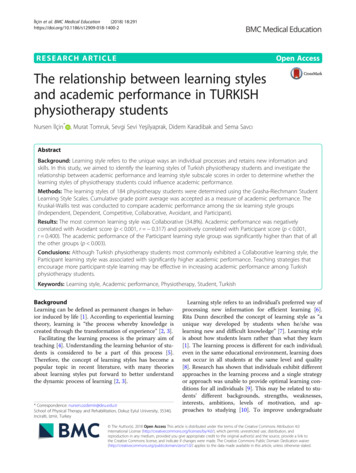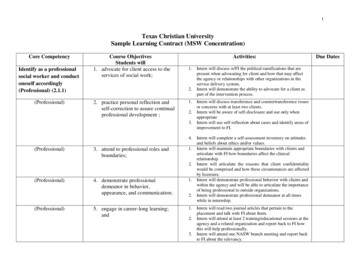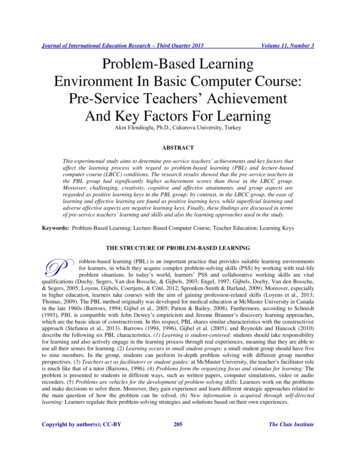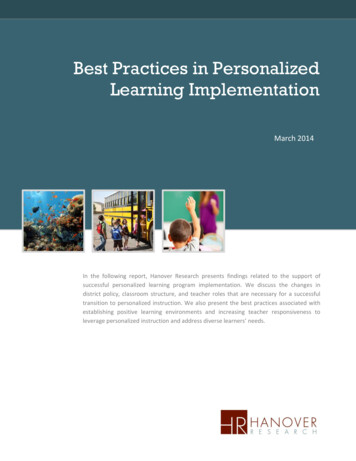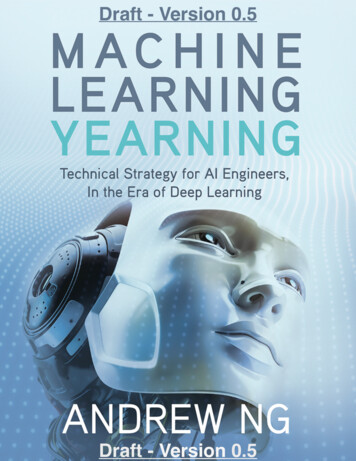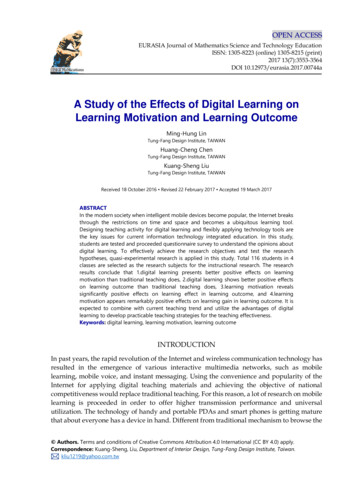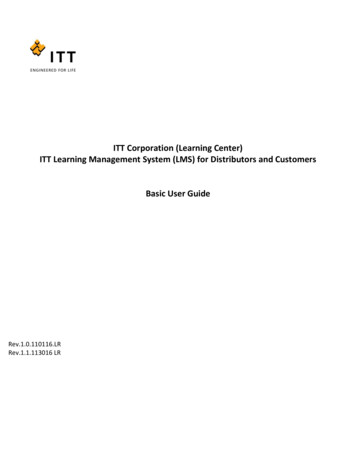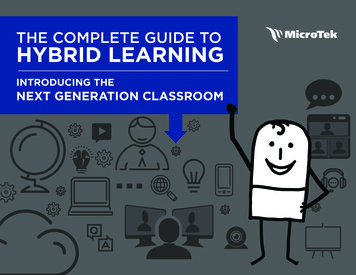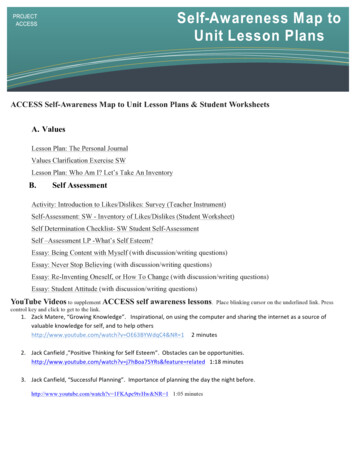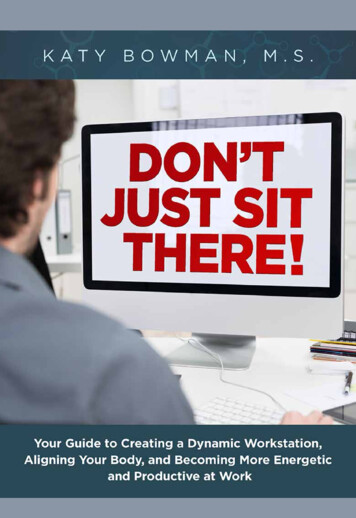
Transcription
We’re all learning that sitting too much is dangerous—but whoknew that standing up doesn’t fix the problem? Don’t Just SitThere offers a true alternative to our sedentary workplaces, givingconcrete steps to becoming more healthy and more productive.—Robb Wolf, New York Times bestselling author of The Paleo SolutionThe next time you are told to “take a seat,” you may reconsiderhow you configure yourself. Katy’s text rearranges the physiologicalblind spots caused by the negative consequences of body idleness.Katy’s book captures your attention from eyeball to footfall.—Jill Miller, author of The Roll Model: A Step by Step Guide to ErasePain, Improve Mobility and Live Better in your BodyAs someone who was gung-ho about my standing desk until itstarted making me ache all day, I had a light-bulb moment whilereading this book. It’s not the desks; it’s our whole techno-boundlifestyle. But this book isn’t just a literal eye-opener (my workspace is ruining my eyes, too?), it also provides myriad actionableitems to improve all aspects of your health. This book is a greathow-to manual for examining and creating better movement and abetter quality of life.—Becca Borawski Jenkins, Managing Editor, Breaking MuscleKaty Bowman’s Don’t Just Sit There is more than just timely, it isabsolutely necessary in our increasingly technological lives. Sheoffers sane, scientifically validated, and approachable techniquesfor getting the most out of our bodies, even when we do findourselves sitting. What’s more, she tempers the sitting sensationalism, taking us past the memes and headlines, empowering uswith the knowledge and tools we need to care for our frames for alifetime.—Daniel Vitalis, health motivator, author, ReWild Yourself Magazine
DON’TJUST SITTHERETRANSITIONING TO A STANDING AND DYNAMICWORKSTATION FOR WHOLE-BODY HEALTH
DON’TJUST SITTHERETRANSITIONING TO A STANDING AND DYNAMICWORKSTATION FOR WHOLE-BODY HEALTHKATY BOWMAN, M.S.FOREWORD BY MARK SISSON
Copyright Katy Bowman 2015Foreword Mark Sisson 2015All rights reserved. No part of this publication may be reproduced, distributed,or transmitted in any form or by any means, including photocopying, recording,or other electronic or mechanical methods, without the prior written permission of the publisher, except in the case of brief quotations embodied in criticalreviews and certain other noncommercial uses permitted by copyright law.Printed in the United States of America.First Printing, 2015 ISBN-13: 978-1-943370-00-9Library of Congress Control Number: 2015946726Propriometrics Press: propriometricspress.comCover Design: Caroline De VitaInterior Design: Agnes Koller, figdesign.caIllustrations: Jillian NicolCover image: iStock.com/OJO ImagesPhotographs: Michael Curran, Galina DenzelAuthor photograph: J. Jurgensen PhotographyThe information in this book should not be used for diagnosis or treatment, oras a substitute for professional medical care. Please consult with your health careprovider prior to attempting any treatment on yourself or another individual.Publisher’s Cataloging-In-Publication Data(Prepared by The Donohue Group, Inc.)Bowman, Katy.Don’t just sit there : transitioning to a standing and dynamic workstation for wholebody health / Katy Bowman, M.S. ; foreword by Mark Sisson ; illustrations: Jillian Nicol.pages : illustrations ; cmIncludes bibliographical references and index.ISBN: 978-1-943370-00-91. Exercise therapy. 2. Sedentary behavior--Physiological effect. 3. Human locomotion--Health aspects. 4. Microcomputer workstations--Health aspects. 5. Health. I.Sisson, Mark, 1953- II. Nicol, Jillian. III. Title.RM725 .B692 2015615.82 2015946726For my parents, who both worked very, very hard.
ALSO BY KATY BOWMANEvery Woman’s Guide to Foot Pain Relief (BenBella Books, 2011)Alignment Matters (Propriometrics Press, 2013)Move Your DNA (Propriometrics Press, 2014)Whole Body Barefoot (Propriometrics Press, 2015)
contentsFOREWORD BY MARK SISSON.xiiiSECTION 1: THINK .1Chapter 1: Sitting isn’t really the new smoking!. 3Chapter 2: The single best ergonomic position? No suchthing!. 9Chapter 3: Building the perfect workstation for you. 13SECTION 2: MOVE . 33Chapter 4: Sitting well. 35Chapter 5: Standing well. 43Chapter 6: Working out on company time: The subtle stuff. 61Chapter 7: Big movements to do at your desk. 71Chapter 8: Standing and injury 81Chapter 9: The big picture. 89THE PROGRAM. 95APPENDIX: USEFUL PRODUCTS. 112REFERENCES & ADDITIONAL READING. 121INDEX. 129ABOUT THE AUTHOR. 134
forewordAS REGULAR READERS of MarksDailyApple.com know,I’m one of the original fans of the standup desk movementthat has really picked up steam in recent years. Several yearsago at our Primal Blueprint headquarters in Malibu, CA, werigged up some prehistoric primal standup desks by stackingtogether several varieties of USPS shipping boxes to raisemonitors and keyboards. Today, each employee workstationhas been outfitted with equipment specifically designed for“working out” on company time. Friends who drop in andsee my setup (which includes a desk “kickstand” as describedon page 42) have mentioned it looks like I’m typing emailswhile sitting on a pogo stick! Whatever, it’s hard to deny therenewed flexibility and suppleness in my hip flexors.Now many employees groove along, accumulating twoto three miles of treadmill walking each day, in betweenperiods of simply standing on a stationary treadmill belt orsitting down on a stool or regular chair. Meanwhile, mainstream media has embraced the hot tagline that “Sitting isthe New Smoking.” Progressive-minded large corporationsare retrofitting cubicles with standup options, and millions
xviDON’T JUST SIT THEREof individuals working from home and even in dorm roomsare becoming more cognizant of the need to avoid prolongedstationary periods with their bodies hunched over keyboards.I’m honored to write the foreword to Katy’s book, as Ibelieve she is the world leader in this burgeoning field ofbiomechanics and how it relates to optimal human development and health—not only when working, but also duringphysical activity, and even while relaxing or sleeping. Katy’spresentations on biomechanics blend the “separate” fields ofbiological, physical, and kinesiology science with a practical,hands-on approach to working with real people. She alsolives her message—writing, teaching, and maintaining a busyglobal travel schedule without sacrificing her body’s need formovement.When I initially reached out to Katy about collaboratingon a solution to the “sitting is the new smoking” problemby promoting my beloved standup desks, I have to admit Iwas taken aback by her initial comments. “Is sitting the newsmoking? Not really,” countered Katy. “It’s not as simple astrading a sitting desk for a standup desk. If you stand thereall day in one position you’ll be no better off than you werebefore except you’ll be more tired, stiff, and sore!”Katy’s view makes intuitive sense to me. Even with myenthusiastic adoption of standup working, I must admit Ihave a couple of “bailout” spots at my house where I grabmy laptop and settle in with multiple pillows in my comfortable outdoor daybed structure (taking care to keep my spinein good alignment of course!), or perch on a simple stool atthe kitchen counter for a change of pace. I felt guilty beforetalking to Katy, like I was cheating or simply didn’t have theFOREWORDstaying power yet of an all-day standup worker. Now I realizeI’m just doing what my genes are calling for—variation inpositioning and routine.Indeed, we are challenged with a complex biomechanicalproblem here, for which there is no simple solution. I alwaysreference the ancestral model when sorting through optionsto counter the health-compromising effects of high-tech life,and indeed we can reference the example of our ancestors inthis case too. Most prehistoric hunter-gatherers likely liveda life that was wildly fluctuating in physical activity fromday to day. They were generalists in every sense of the word,because their lives depended upon them possessing a varietyof physical skills and abilities to navigate the ever-presentchallenges and dangers of primal life.Today, in order to make an economic contribution to hightech modern life, we’ve essentially been forced to becomespecialists. This is great for us when we need an electricianto remodel our bathroom or an orthopedic surgeon to scopeour knee. However, we as individuals must recognize thisdiscord, from an evolutionary perspective; from a physical,cellular perspective; and also from an intellectual perspective. Richard A. Heinlein, author of Stranger in a StrangeLand, captured this sentiment memorably when he wrote,“A human being should be able to change a diaper, plan aninvasion, butcher a hog, conn a ship, design a building, writea sonnet, balance accounts, build a wall, set a bone, comfortthe dying, take orders, give orders, cooperate, act alone, solveequations, analyze a new problem, pitch manure, programa computer, cook a tasty meal, fight efficiently, die gallantly.Specialization is for insects.”xvii
xviiiDON’T JUST SIT THEREAs Katy will detail here, humans are designed for a fractalexistence featuring an assortment of daily movement andphysical challenges. And these genetically optimal physicalchallenges are not just the rote stuff like walking your twomiles or cycling through your seven strength training stationsat the gym, but spontaneous challenges that get your bodymoving in new and extraordinary ways.And sorry to break it to you, folks, but being a fitnessenthusiast, or even a serious competitive athlete, doesn’t giveyou a free pass here. As breaking science has revealed withthe so-called active couch potato syndrome, even those whofollow a devoted schedule of daily workouts are not free fromthe disease risk of sedentary living when the majority of theirdays are spent commuting, working a desk job, and enjoyingimmobile leisure pursuits such as screen entertainment.Furthermore, even those with active jobs—for example, alineman for the utility company, a building contractor, ora shipping and receiving agent— are generally engaged inrepetitive tasks that only mobilize a fraction of their jointsand muscles. And the grind of physical labor (particularly when using inefficient mechanics) can lead to assortedoveruse injuries and health problems.The solution here is not more visits to the gym or moremiles on the road, or even installing a standup desk andcarrying on. Every little step away from being sedentaryhelps, of course, but we need to mix things up a bit—make that a lot—in daily life. Be wary of routines, moderncomforts, and all manner of sedentary momentum. If youenjoy your evening television programming, can you do afew sets of planks and squats while your eyes are glued to theFOREWORDdigital stimulation? Will your office and company survive ifyou break free from your desk frequently to take phone callsor even personal meetings while cruising around the officecourtyard?Don’t worry, there will be no shortage of ideas and evenedicts presented here, but taking action is up to you. Whileat first it might seem like a hassle and an inconvenience totake the stairs instead of the elevators or to always park at thefarthest spot in the lot instead of habitually trolling for theclosest, pretty soon you will integrate new habits of this sortsuch that creative movement becomes second nature. Then,you will set a powerful example for your fellow humans whoblithely scheme and strategize ways to elevate their lazy scorecards to world-class levels.Let’s leave specialization to the insects, and rejectmonotony, laziness, and dated social conventions. Instead,with some increased awareness and new tools and skills, youcan start enjoying your hard-wired preference for an active,spontaneous, playful daily existence. Good luck with yourjourney!Yours in health,Mark Sisson, Malibu, CAxix
section 1Think
chapter 1SITTING ISN’T REALLYTHE NEW SMOKING!IF YOU HANG out on Internet health sites, chances areyou’ve read a headline that screams something like “Sittingis the New Smoking!” These headlines imply that sitting,like smoking, is statistically associated with numerous healthissues, including death from cardiovascular disease andcancer, and that it will take some time before we all wise upand quit.As a long-time proponent of the Stop Sitting So Muchcampaign, I am thrilled that sitting is finally getting attentionin the media. Research into diseases associated with sitting(like cancer) aren’t new. The first article I ever read (in 1997)
4DON’T JUST SIT THEREon sitting and cancer risk was published in 1993, whichmeans scientists, at least somewhere, have known about thisrelationship for at least 20 years.In light of sitting research and sit-less campaigns, healthyminded individuals have been super motivated to get out oftheir chairs and onto physio balls, standing workstations,and tread-desks. The options to sit less are endless, so thenotion that standing in one place is the solution to sitting somuch reminds me of the joke about all accidents happening15 miles from your home. “I read that all accidents happenwithin 15 miles of one’s house, so I moved.” Or, “I read thatsitting kills, so now I’m afraid to stop standing.”As I explain more deeply in my book Move Your DNA:Restore Your Health Through Natural Movement, the sittingitself isn’t really the problem; it is the repetitive use of a singleposition that makes us literally become ill in a litany of ways.For example, muscles will adapt to repetitive positioning bychanging their cellular makeup, which in turn leads to lessjoint range of motion. This muscle and joint “stiffness” canlead to a stiffening of the arterial walls within these muscles.The positive news is that, because we’ve all been sitting(static) the same way for decades, changing our static positioning (i.e., standing more) can improve our health, as canmoving intermittently throughout the day.As a biomechanist, I help people understand that the shapeof their body on the gross level (i.e., their posture) affects theshape of the cells themselves. In other words, the way youhave been sitting has changed the tiny parts that make upyour structure, like the shape and density of your bones, thelength of your muscles and tendons, and the resting tensionTHINKin your connective tissues. The adaptation to sitting onthis deeper, cellular level means that reaping the benefits of“not sitting so much” requires more than just swapping onestatic positionREAPING THE BENEFITS OF “NOT SITTING SOfor another—MUCH” REQUIRES MORE THAN JUST SWAPPINGit requires anONE STATIC POSITION FOR ANOTHER—ITentire overhaulREQUIRES AN ENTIRE OVERHAUL OF THE WAYof the way youthink about andYOU THINK ABOUT AND MOVE YOUR BODY.move your body.Eventually the “all you need to do to fix yourself is to startstanding” advice made me realize that a more thoroughbreakdown or explanation was needed—starting with themetaphor.Sitting and smoking are different: sitting itself isn’t thecreator of ill effects the way smoking a cigarette is. Sitting—the position—is perfectly harmless when “consumed” appropriately. It’s not like putting your butt into a chair makesyou ill; as they say, “it’s the dose that makes the poison.”Language can also get us into trouble when we’re seekingsolutions, because we keep equating sitting with not moving,but in many cases, the physical effects of sitting are just asmuch created by repetitive geometry (always sitting in thesame way) as they are by the metabolic changes that comewith being sedentary. So sitting differently can improveyour health in the same way that standing can—which isgreat news for the millions of people who aren’t yet quitefit enough to stand for considerable amounts of time. Yes,even you—who want to change your risk profile for diseasebut feel trapped by your current physical limitations—can5
6DON’T JUST SIT THEREchange how you sit andimprove your health on acellular level.Your arteries are arranged in aI’d be remiss if I didn’tspecific way to maximize presteaseout how “standing”sure gradients and keep bloodis not the simple, turnkeyflow smooth, but this geomsolution we might think itetry changes with your posture.is. Every way of standingProlonged alterations in arterialgeometry can change the wayis not equal, and there areblood flows through your tubes,ways to stand that loadcreating scenarios where theyour cells and create posiloads to the vessel wall inducetive adaptations. What’schanges to the cells—causingthe point of standing in athem to go from atheroproway that crushes your bodytective (protective against thein the same manner thatformation of plaque) to atherositting did?genic (promoting the formation ofThe problem withplaque).equating sitting withsmoking (or equatingstanding up with being the end-all solution) is that it oversimplifies the problem to be the act of sitting. Heraldingstanding still as the solution to sitting still perpetuates theproblematic belief that there is a way we can consume a vastamount of stillness—whether it be sitting or standing—andstill have the level of health necessary for a thriving quality oflife.My reason for writing this book is that, right now, youare probably super motivated to sit less, and I’d like to helpyou transition appropriately. In order to do that, you needa deeper prescription for sitting less than simply “standingANATOMY BITTHINKmore.” Therefore, I’ve included the following four sections inthis book: How to build a perfect workstation How to sit better How to stand better How to work out on company time!The last section is a two-parter, because not only will Igive you exercises to de-chair your body on your movementbreaks, but I will also show how you can exercise your bodywhile you are simultaneously working (you won’t need extratime outside of work to do these exercises).RESEARCH CORNERSITTING AND CORONARY ARTERY CALCIFICATIONAccording to the Centers of Disease Control (CDC), coronary arterydisease is the leading cause of death in the United States. The amount ofsitting typically required for office work is associated with increased coronary artery calcification, an early marker for heart disease risk. One study,analyzing heart scans and accelerometer data (a device that measureshow much you move) of more than 2,000 adults, found that each hourof sedentary time per day on average was associated with a 14 percentincrease in coronary artery calcification burden. The association betweencalcification and sitting was independent of exercise activity and othertraditional heart disease risk factors.American College of Cardiology. (2015). Excess sitting linked to coronary artery calcification, anearly indicator of heart problems. ScienceDaily, March 5, 2015. Retrieved online: .7
8DON’T JUST SIT THERESCREEN TIMEI’d feel like a jerk if I didn’t also mention that while sitting is indeed arisk factor for death and disease, so is screen time. Which meansthat even when you stand up, if you continue to look at a computerchapter 2screen or smartphone all day, you haven’t transitioned out of thedanger zone as much as you’d like. Screen time and lack of move-ment are correlated, but they are separate variables and should beapproached independently. Even if you’ve developed the habit oftaking a daily walk, you still need to look at the frequency with whichyou’re using your device (handheld or otherwise) and reduce it.Anyone who has been on a diet knows that starvation doesn’t work.The most successful way to approach a change in diet is throughsmall changes—cutting back on processed carbs or seeking organicTHE SINGLE BESTERGONOMIC POSITION?NO SUCH THING!produce instead of conventional, for example.Here’s your homework: Instead of resolving to throw your smartphone into the ocean, practice taking small breaks away from it.Pulling (tearing, ripping, etc.) yourself away from those addictivescreens for a short time (three minutes) a dozen or so times a day isa habit you can cultivate. Needing your screen for work is one thing;being addicted to it is another. Use that tech break to take a three-minute walk or stretch. Bored? Don’t check your email again. Just putthe phone down and touch your toes instead. Standing in line at thebank? Stand on one leg and practice some of the steps to alignmentdiscussed in Chapter 5. Go to the bathroom “alone” (read: withoutyour tech-buddy) for a change and focus on how you get down ontoand up off the toilet. There is health to be found in three-minutesessions. You can find it.MODERN ERGONOMICS IS not the scientific pursuit ofwhat is best for the human body, but the scientific pursuit ofhow the human body can be positioned (in one position, foreight or more hours at a time) for the purpose of returningto work the next day, and then the next and the next and thenext. Before you apply ergonomic data to your workstation,consider this: Finding an “optimal working position” is notabout your long-term health as much as it is about your production value over a short period of employable time. This isn’t tosay that your office’s ergonomics expert doesn’t have your bestinterests at heart, but that there’s a broader perspective to be
10DON’T JUST SIT THEREconsidered. There reallyisn’t a healthy way for thebody to sit for long periodsAccording to the Journal ofOccupational and Environmentalof time; there is only a wayMedicine, health care expento sit that loads the partsditures are nearly 50 percentdamaged by chronic sittinggreater for workers who reportin a less damaging way.high levels of stress.Therapeutically, we tendto solve pain problems byseeking a “better” body position than our current one. Butthe problem with our bodies is rarely the position we holdthem in; the problem is the high frequency at which we arein a repetitive position. Being in a single position repetitively,as we have been when chair-sitting (or computer-using, orcar-driving, or stressing), means that there are an infinitenumber of other positions going unused.For decades, researchers have been trying to figure out thebest way to organize the body for optimal performance atthe office. The underlying flaw in much of the research—orat least in the presentation of the research—is that it failsto highlight the use of a single position as the problem. Ourquest to find an optimal position for stillness will alwaysbe frustrated by the problems inherent in a lack of movement. Fortunately, in light of new understanding regardingthe importance of all-day movement as opposed to exercise buried in a mostly sedentary day, there is a new trend inhealth research across the board: to look at the physiologicaland biomechanical effects of the sitting behavior.I’ve brought all of this up because I want you to understand why I’ve chosen write a book on why the sedentaryANATOMY BITTHINKdesk—whether it be a sitting or standing one—is theproblem. If we keep trying to solve the “what’s the best wayto be in front of my computer” problem, we’ll miss that theanswer is “as little as possible.” That all being said, you stillneed to work, be in front of your computer, and commutewith regularity. But our lack of knowing (yet) how to solvethe problem shouldn’t keep us from discussing the actualproblem. The fact that we must work can be considered aswe try to figure out how to use more of our bodies’ ranges ofmotion, to prevent our muscles and other body tissues fromatrophying in this movement drought.There are evidence-based ways to sit and stand better,but the conditions that make these positions better for youare limited in scope. Which is why in addition to makingpostural adjustments, which introduce new body loads andrequire different muscles to work, you also need to movemore throughout the day—throughout being the key term.The newest research shows that you can be active (as in,faithfully completing your daily workout at the gym orlogging “10 miles ran today” on your marathon-trainingprogram) and still be sedentary (as in, commuting back andforth each day to your desk job and consuming extensivedigital entertainment in your leisure hours).Let’s work to solve theproblem by not just gettingOUR QUEST TO FIND AN OPTIMALup and out of our chairs,POSITION FOR STILLNESS WILLbut by creating intermitALWAYS BE FRUSTRATED BY THEtent movement—bothPROBLEMS INHERENT IN A LACKon the large and smallOF MOVEMENT.scale—while still getting11
12DON’T JUST SIT THEREour business/work done. As you proceed through the nextsections about workstations, sitting, standing, and doingclever exercises in the office, always keep the big-picture goalin mind that these optimal setups are really way stations toflow through over the course of the workday.chapter 3IS YOUR JOB STRESSING YOU OUT?When you’re stressed, an alarm goes off in your brain to which yourbody responds, preparing your body for defensive action. If youwork at a circus as a tiger trainer, this lifesaving fight-or-flight mech-anism probably comes in handy. But if you’re busy dumping muscle-tensing, tunnel-vision-making, respiration-and-heart-rate-increasingBUILDING THE PERFECTWORKSTATION FOR YOUhormones into your bloodstream every time you open your email orevery time the office jerk strolls by your door, job stress can easily bebreaking down your body tissues, escalating your risk of injury anddisease. The solution: Instead of (only) adding a new workstation andexercises to your routine, see where work stress can be eliminated.Does checking your email fill you with a sense of dread? Don’t checkyour email 20 times a day (read: 20 biochemical dumps and 20clenches of the jaw and neck muscles). Add an automatic responseto emails: “To increase my productivity, I check and respond to emailstwice a day at these times .” Pick the times that work best foryou according to your schedule. Add a line like, “For urgent matters,please call me directly at .” Unless it’s the phone that drivesyou mad. Then, add a message to your voicemail saying that you onlycheck your phone messages once a day and for faster service, sendan email! Whatever your preference, you can ask people to accommodate you. Your health and productivity depend on it!IF SOMEONE ASKED your position at work, you wouldgive them the title of your job—but couldn’t “sitting” alsobe a valid answer? Of course it could, which is why you’rereading this book on standing workstations. In fact, thisisn’t (only) a section on sitting vs. standing workstations; it’sabout all the body positions in between and around chair-sitting and standing that you can assume while working.Most people are familiar with the term “form” as it appliesto exercise and working out, but our use of form is verylinear. If we were magically set free from the cages of ourmodern, agricultural, post–Industrial Revolution, tech-based
14DON’T JUST SIT THEREculture and transported back to earlier times where we hadto find food and water daily, build shelters, and carry ourworldly possessions with our arms, our bodies would beexposed to a constant stream of work and variety. We’d bewalking on varying terrain, with all sorts of random anglesand grades under our feet; we’d be sitting at different heights,in different ways, on a wide range of objects; we’d be usingour arms and backs in whatever ways were necessary. Soclearly, to think of standing as the only alternative to sittingin a chair is very limiting when it comes to optimizing ourbody’s function in daily life.The key to finding health through the use of alternative workstations is to make sure your setups are as fluid aspossible. The more time you spend at a “fixed” station—even a super fancy setup with a five-star rating—the closeryou will be to exactly where you were when you were sittingall day. Sure, standing is great after a decade spent sitting,but without the refreshment of your mechanosensors (tinysensors in your cells), your body will just begin a new set ofadaptations to your new static position. And it’s important tonote that adaptations do not necessarily equal improvements.Let’s say you spent every last dollar and free minute youhad getting this book. There’s no money left to buy yourdream desk setup or time to shop for it. Here’s a secret: Ifyou sit cross-legged in your chair, right now as you’re readingthis, you’ll be doing your body better because you’re loadingdifferent parts. Don’t want to (or can’t) cross both legs at thesame time? Try one ankle over your opposite knee. After afew minutes, switch to the other. Do you work frequentlyfrom a laptop? Sit on a pillow on the floor with your legs outTHINKin a V-position and set your computer on a stack of books.Sit cross-legged with your computer on the floor or on abox, lie on your stomach, stand at a counter, or at a desk—all within the space of an hour, if it suits you. Get what I’msaying? The combinations and permutations of a workstationare endless. Sometimes we get so fixated on “doing it the rightway” that we forget “the right way” is “as many different waysas you can.”MECHA
ago at our Primal Blueprint headquarters in Malibu, CA, we rigged up some prehistoric primal standup desks by stacking together several varieties of USPS shipping boxes to raise monitors and keyboards. Today, each employee workstation has been outfitted with equipment


